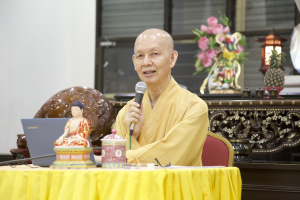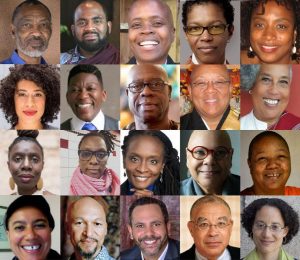
Editor’s note: This feature was first published in the now-retired Bodhi Journal, Issue 6, December 2007.
The Abhidhamma-pitaka is the third Basket (pitaka) of the Theravada Tipitaka. The Pali term ‘Abhidhamma’ has an ambiguous meaning, of which two primary meanings given in the Pali tradition are noteworthy:
1. auxiliary (atireka) doctrines and
2. exceptional/superior/highest (visesa/vasisaha/uttama) doctrine.
Ven. Buddhaghosa, the great Pali commentator, defines the term ‘Abhidhamma’ as – ‘that which exceeds and is distinguished from the Dhamma’. Abhidhamma, therefore, holistically conveys the meaning of ‘special/supplementary teachings of the Buddha’. Traditionally, the Abhidhamma-pitaka contains seven books viz.: (i) The Book of Enumeration of Phenomena, (ii) The Book of Analysis, (iii) The Book of Discussion on Elements, (iv) The Book of Individual Concepts, (v) The Book of Points of Controversy, (vi) The Book of Pairs, and (vii) The Book of Synthesis.
Unlike the unanimously accepted Sutta-Vinaya-pitakas, the authenticity and authority of Abhidhamma as direct Words of the Buddha (Buddha-vacana) remains as a controversy.
The Theravada orthodoxy, nonetheless, based on the Atthasalini (Buddhaghosa’s commentary to the 1st book of Abhidhamma), holds the popular traditional view that Buddha himself was the first Abhidhammika, adding that in the fourth week after His enlightenment, Buddha contemplated the seven books of the Abhidhamma-pitaka. The commentary further mentions that prior to his 7th annual rainy retreats, Buddha, having ascended to the Tavatimsa heaven, preached the Abhidhamma at a full stretch of three months to the gods assembled from ten thousand world systems headed by his mother goddess Mahamaya Devi. The reason for this is that in order to have a complete picture of Abhidhamma, it should be taught unceasingly from the beginning to the end; and only the gods, it is said, could remain in one position for full three months. Being human, however, Buddha came down onto earth for his midday meals leaving behind a self-created image of himself to continue the session in his absence. While on earth He met Ven. Sariputta and transmitted the Abhidhamma to him who in return taught to his own set of disciples. Subsequently, the Abhidhamma was retained in an oral transmission for generations up until the final writing down of the Tipitaka in Sri Lanka in the 1st century B.C.
The traditional view, as we shall see below, has a number of inconsistencies, if not defects, which hardly correspond with the evidential information we have in Suttas, Commentaries and Chronicles about the origin of the Abhidhamma-pitaka.
Firstly, the Pali commentaries state that one of the conditions under which Ven. Ananda became Buddha’s chief attendant was that the latter should repeat to the former what has been preached to others in his absence. Accordingly, Buddha should have transmitted the Abhidhamma, preached in Tavatimsa to Ven. Ananda, not to Ven. Sariputta. Further, why did Buddha preach Abhidhamma in Tavatimsa and not in Tusita where his mother was supposed to have reborn as a deva?
Secondly while referring to His teachings, Buddha explicitly said ‘Dhamma and Vinaya (Disciplines) preached and promulgated by me would be your teacher when I am gone’. This suggests that if Abhidhamma ever existed in the first place, Buddha would have mentioned alongside the Dhamma and Vinaya. The Cullavaggapali of the Vinaya-pitaka, one of the most authentic Theravadin texts, records the proceedings of the first Buddhist council held just three months after the demise of the Buddha. In that account, quite surprisingly, there is no mention of the recital of the Abhidhamma-pitaka. However ‘the three parts of the (Pali) Canon are referred to for the first time in a late part of the Sutta-vibhanga in the Vinaya-(pitaka)’. This is followed by the Sumangalavilasini (the commentary to the Digha Nikaya by Ven. Buddhaghosa),which says in its introduction that the Abhidhamma-pitaka was also recited alongside the Dhamma and Vinaya-pitakas. This claim is supported by the Dhiga- and Majjhima-bhanakas of the Pali Bhanaka tradition.
However, the Mahavamsa, a prominent Sri Lankan Pali chronicle, concludes its introduction to the account of the first Buddhist council saying ‘Dhamma-vinaya’ was recited (no mention of Abhidhamma). Nonetheless the fourth chapter of the same chronicle says that the participants in the second Buddhist council, held a century after Buddha’s demise, were ‘Pitakattayadharins’ – a term suggesting that the participants were ‘Bearers of the Tipitaka’ (i.e. Sutta, Vinaya and Abhidhamma).
Further the fifth chapter of the same chronicle claims that the participants of the third council, held roughly three hundreds after Buddha’s demise, were ‘Tipitakas’ a term also suggesting the participants were ‘Masters of the Tipitaka’. According to the Mahavamsa’s and some other authentic texts like Cullavaggapali’s accounts, it’s much justifiable to assume that the recitation or perhaps the formation of the Abhidhamma-pitaka probably took place after the first Buddhist council.
Bhikkhu KL Dhammajoti, referring to the Abhidhamma-pitaka as the last of the Tipitaka, says, without coming to a specific conclusion regarding the origin of Abhidhamma, ‘this very probably reflects the historical fact that the Abhidharma texts were evolved and compiled as a pitaka later than the other two’. Here if it was so, then it was also logical to conclude that the Vinaya-pitaka was composed later than the Sutta-pitaka for, the former position comes after the latter. But from the ongoing discussion we are aware that the Sutta- and the Vinaya-pitakas were recited almost simultaneously at the first Buddhist council. It was only a matter of naming the pitakas rather than determining their respective origins by their traditional sequence.
Frauwallner is one of the few scholars who say that the ‘Abhidhamma-pitaka originated between 2nd century BC and 2nd century AD’. This date, to a large extent, is contradictory because the Atthakathas and the Vatsakathas have it that the Abhidhamma-pitaka came to an end after Ven. Moggallaputta Tissa, the president of the third council, composed and compiled the last book of the Abhidhamma-pitaka immediately after the council and that the whole of the Pali Tipitaka together with its commentaries was committed to writing in the first century B.C. Accordingly, the full Abhidhamma-pitaka was already extant one century before the date given by Frauwallner as the origin of the Abhidhamma-pitaka.
Thus the modern scholarship is yet to arrive at a unanimous conclusion on the origin of the Abhidhamma-pitaka. What the modern scholars like Hinuber could suggest is that ‘the Abhidhamma-pitaka is considerably younger than both Sutta- and Vinaya-pitakas’. Hence, the modern scholarship concludes that Abhidhamma was a gradual development, interpretation, further elaboration, organization and systematization of the teachings found in the Sutta-pitaka. Terms like ‘abhidhamme’ often alongside ‘abhivinaye’ occur in the Sutta- and Vinaya-pitakas,but this particular term does not necessarily mean the form of standardized Abdhidhamma we have today. However since some suttas have the characteristics of Abhidhamma we shall see some of them below so to determine how far it’s logical to say that Abhidhamma has its origin in the Sutta-pitaka.
The Mahagosihgasutta of the Majjhima Nikaya refers to monks like Venerables Sariputta, Mahakassapa, Moggallana and so on engaged in ‘abhidhammakatha’ in the form of questioning and answering.
Similarly we find ‘vedalla-katha’ – also a question and answering session on doctrinal issues either between the Buddha and disciples or among the disciples themselves. Accordingly the Mahavedallsutta and Calavedallasuttaof Majjhima Nikaya are a testament to this category.
Further in the Suttanta we also find ‘Vibhanga (exposition)-methodological teachings in brief and summarized manner which are to be further elaborated on either by Buddha himself or by a proficient disciple.
Apart from these, the most important of the Abhidhammic style teachings found in the suttanta are the ‘mitikas’– meaning (as defined by Bhikkhu KL Dhammajoti) ‘a matrix in the form of a list summarily enumerating topics to be elaborated upon’. Long lists of such mitikas can be found in suttas like Sangitisutta and Dasuttarasutta of the Digha Nikaya. Accordingly these mitikas are the basis of all the seven texts of the present day Abhidhamma-pitaka.
Thus mitikas found in the Suttanta are considered to have served as a major basis for the development and origin of the Abhidhamma-pitaka. This is further pushed forward by the fact that ‘…in the ancient triple designations given to the specialists of the Buddhist Canon – vinaya-dharas, sutta-dharas, (and) mitika-dharas’ were mentioned in stead of abhidhamma-dharas for the last one. So it’s highly logical that Abhidhamma could have resulted from the further elaboration and systematization of such mitika-type teachings already found in the Suttanta and to a lesser extent the Vinaya-pitaka.
Given the highly technical, profound and penetrative teachings contained in the Abhidhamma-pi?aka, often said to be the philosophical, psychological & ethical teachings of the Buddha, it, (the Abhidhamma-pitaka) is unmistakably the genius work produced by enlightened persons or person, a Buddha or a person equal to Buddha. This is supported by Narada when he says, ‘whoever the great author or authors of the Abhidhammamay have been, it has to be admitted that he or they had intellectual genius comparable only to that of the Buddha’. Even though Abhidhamma is said to surpass the Suttanta, the vohra-vacana, it is certainly not suggested that one is inferior or superior to the other. Both differs only in the scope of exposition and method but both have the enlightenment potentiality – the door to nibbana, for Buddha’s teachings have only one taste – the taste of nibbana, the apex of Buddhist spiritual practice.






